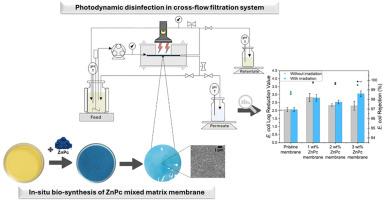结合光动力消毒在水过滤过程中的细菌和病毒管理与锌酞菁嵌入细菌纤维素膜
IF 9
1区 工程技术
Q1 ENGINEERING, CHEMICAL
引用次数: 0
摘要
生物污染仍然是水处理中膜寿命和效率的主要障碍,这推动了对具有内在抗菌性能的膜的需求。本研究展示了一种新的一步生物合成方法,通过将ZnPc直接加入到Komagataeibacter hansenii (K. hansenii)生长培养基中来制备酞菁锌(ZnPc)功能化细菌纤维素(BC)复合膜。尽管已知ZnPc在照射下具有抗菌活性,但它在黑暗条件下存在于培养基中并不影响细菌活力或纤维素生产,从而使发酵过程中成功地原位形成混合基质膜。结构表征证实,ZnPc掺入没有改变BC的纳米纤维结构。复合膜表现出可见光激活的光动力活性,增强了光催化和抗菌性能,静态条件下的光降解实验证明了对亚甲基蓝的有效光动力降解,并强调了ZnPc-BC复合膜在同时灭活微生物和去除有机污染物方面的广阔潜力。过滤实验证实了ZnPc-BC复合膜的细菌排除率和抗生物污染能力,在辐照下,3 wt%的ZnPc-BC复合膜的大肠杆菌排除率为99.8±0.20%,渗透回收率为98.8±0.9%。然而,由于在中性pH下的静电排斥,抗病毒活性很小,这限制了病毒的吸附并降低了光动力失活效率。总的来说,这种生物集成制造策略为生产多功能膜提供了一种可持续和可扩展的途径,该膜结合了生物衍生纳米纤维支架和光激活抗菌特性的优势。在生物合成过程中,ZnPc有效地结合到BC膜基质中,为绿色制造用于水处理和生物医学应用的高级过滤材料开辟了新的机会。本文章由计算机程序翻译,如有差异,请以英文原文为准。

Integrating photodynamic disinfection during water filtration for bacteria and viruses management with zinc phthalocyanine-embedded bacterial cellulose membranes
Biofouling remains a major obstacle to membrane longevity and efficiency in water treatment, driving the need for membranes with intrinsic antimicrobial properties. This study demonstrates a novel, one-step biosynthesis approach for fabricating Zinc Phthalocyanine (ZnPc)- functionalized Bacterial Cellulose (BC) composite membranes by incorporating ZnPc directly into the Komagataeibacter hansenii (K. hansenii) growth medium. Despite the known antimicrobial activity of ZnPc under irradiation, its presence in the culture medium in dark conditions did not compromise bacterial viability or cellulose production, enabling the successful in situ formation of a mixed matrix membrane during fermentation. Structural characterization confirmed that ZnPc incorporation did not alter the nanofibrous architecture of BC. The composite membranes exhibited visible-light-activated photodynamic activity, enhancing both photocatalytic and antimicrobial performance, with photodegradation experiments under static conditions demonstrating efficient photodynamic degradation of methylene blue and underscoring the broad potential of ZnPc–BC composite membranes for concurrent microbial inactivation and organic pollutant removal. Filtration experiments confirmed the bacterial rejection and the biofouling resistance of the ZnPc-BC composite membranes, with the 3 wt% ZnPc-BC composite membrane achieving 99.8 ± 0.20 % E. coli rejection and 98.8 ± 0.9 % permeance recovery under irradiation. However, antiviral activity was minimal, due to electrostatic repulsion at neutral pH, which limited viral adsorption and reduced photodynamic inactivation efficiency. Collectively, this bio-integrated fabrication strategy offers a sustainable and scalable route for producing multifunctional membranes that combine the advantages of bio-derived nanofibrous scaffolds with light-activated antimicrobic properties. The effective incorporation of ZnPc into the BC membrane matrix during biosynthesis opens new opportunities for green fabrication of advanced filtration materials for water treatment and biomedical applications.
求助全文
通过发布文献求助,成功后即可免费获取论文全文。
去求助
来源期刊

Journal of Membrane Science
工程技术-高分子科学
CiteScore
17.10
自引率
17.90%
发文量
1031
审稿时长
2.5 months
期刊介绍:
The Journal of Membrane Science is a publication that focuses on membrane systems and is aimed at academic and industrial chemists, chemical engineers, materials scientists, and membranologists. It publishes original research and reviews on various aspects of membrane transport, membrane formation/structure, fouling, module/process design, and processes/applications. The journal primarily focuses on the structure, function, and performance of non-biological membranes but also includes papers that relate to biological membranes. The Journal of Membrane Science publishes Full Text Papers, State-of-the-Art Reviews, Letters to the Editor, and Perspectives.
 求助内容:
求助内容: 应助结果提醒方式:
应助结果提醒方式:


